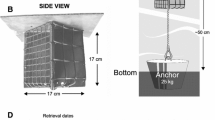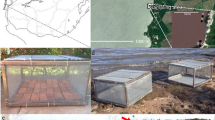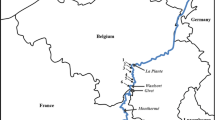Abstract
Similar to other invasive bivalves, Limnoperna fortunei has a variety of effects on other benthic animals. These effects have been studied in the Paraná-Paraguay-Uruguay river system, Río de la Plata estuary, and in the reservoir Embalse Río Tercero since the invasion of South America by the bivalve. The bulk of information accumulated indicates that L. fortunei has predominantly positive effects on meiofaunal groups. Increases in the abundance, biomass, and richness of many groups are attributed to substrate enrichment from the bivalve’s feces and pseudofeces as well as refugia provision amid the valves. Nonetheless, negative impacts on some groups (gastropods) and the homogenization of benthic fauna following colonization by the mussel have also been reported. Large-sized invertebrates can also be detrimentally affected by this mussel’s biofouling, as severe cases of epifaunal growth have been reported for native crabs and mussels, including the invasive clam Corbicula fluminea. However, consequences to affected individuals and impacts at the population level have not yet been assessed. A variety of animals, including fish, crabs, turtles, waterfowl, and some mammals, may benefit from predation on this new abundant prey item, although the consequences to predator populations remain unstudied. Despite marked similarities with Dreissena polymorpha, there are a number of differences regarding the effects of the two bivalves arising from differences in their biology and ambient dissimilarities between their respective environments. The extrapolation of results obtained for Dreissena species, abundant in the L. fortunei literature, can be misleading due to these differences.
Access this chapter
Tax calculation will be finalised at checkout
Purchases are for personal use only
Similar content being viewed by others
References
Armendáriz LC, Rodrigues CA, Ambrosio ES (2011) Relationships between the spatial distribution of oligochaetes (Annelida, Clitellata) and environmental variables in a temperate estuary system of South America (Río de la Plata, Argentina). N Z J Mar Freshw Res 45:263–279
Bially A, MacIsaac HJ (2000) Fouling mussels (Dreissena spp.) colonize soft sediments in Lake Erie and facilitate benthic invertebrates. Freshw Biol 43:85–97
Boltovskoy D, Correa N (2015) Ecosystem impacts of the invasive bivalve Limnoperna fortunei (golden mussel) in South America. Hydrobiologia. 746:81–95
Boltovskoy D, Correa N, Cataldo D, Sylvester F (2006) Dispersion and ecological impact of the invasive freshwater bivalve Limnoperna fortunei in the Río de la Plata watershed and beyond. Biol Invasions 8:947–963
Boltovskoy D, Karatayev A, Burlakova L, Cataldo D, Karatayev V, Sylvester F, Mariñelarena A (2009) Significant ecosystem-wide effects of the swiftly spreading invasive freshwater bivalve Limnoperna fortunei. Hydrobiologia 636:271–284
Botts PS, Patterson BA, Schloesser DW (1996) Zebra Mussel effects on benthic invertebrates: physical or biotic? J N Am Benthol Soc 15:179–184
Brugnoli E, Clemente J, Boccardi L, Borthagaray A, Scarabino F (2005) Golden mussel Limnoperna fortunei (Bivalvia: Mytilidae) distribution in the main hydrographical basins of Uruguay: update and predictions. Anais da Academia Brasileira de Ciências 77:235–244
Bujes CS, Ely I, Verrastro L (2007) Trachemys dorbigni (Brazilian Slider) diet. Herpetol Rev 38:335
Burlakova LE, Karatayev AY, Karatayev VA (2012) Invasive mussels induce community changes by increasing habitat complexity. Hydrobiologia 685:121–134
Burns MDdM, Geraldi RM, Garcia AM, Bemvenuti CE, Capitoli RR, Vieira JP (2006) Primeiro registro de eocorrencia do mexilhao dourado Limnoperna fortunei na bacia de drenagem da Lagoa Mirim, RS, Brasil. Biociências 14:83–84
Capítoli RR, Colling LA, Bemvenuti CE (2008) Cenários de distribuição do Mexilhão Dourado Limnoperna fortunei (Mollusca—Bivalvia) sob distintas condições de salinidade no complexo lagunar Patos-Mirim, RS—Brasil. Atlântica 30:35–44
Carvalho Torgan L, Salomoni SE, Brugalli Bicca A (2009) Diatomáceas sobre Limnoperna fortunei (Dunker), molusco introduzido no Lago Guaíba, Sul do Brasil. Revista Brasileira de Botanica 32:23–31
Carvalho DA, Collins PA, De Bonis CJ (2013) Predation ability of freshwater crabs: age and prey-specific differences in Trichodactylus borellianus (Brachyura: Trichodactylidae). J Freshw Ecol 28:573–584
César II, Martín SM, Rumi A, Tassara M (2012) Mollusks (Gastropoda and Bivalvia) of the multiple-use reserve Martín García Island, Río de la plata river: biodiversity and ecology. Braz J Biol 72:121–130
Colling LA, Pinotti RM, Bemvenuti CE (2012) Limnoperna fortunei na Bacia da Lagoa dos Patos e Lagoa Mirim. In: Mansur MCD, Santos CP, Pereira D, Padula PIC, Leite Zurita ML, Raya RMT, Vilar NM, Aydos BPE (eds) Moluscos límnicos invasores no Brasil. Biologia, prevenção, controle, Redes Editora, Porto Alegre, pp 187–191
Darrigran GA (2002) Potential impact of filter-feeding invaders on temperate inland freshwater environments. Biol Invasions 4:145–156
Darrigran GA, Martin SM, Gullo B, Armendariz L (1998) Macroinvertebrates associated with Limnoperna fortunei (Dunker, 1857) (Bivalvia, Mytilidae) in Río de la Plata, Argentina. Hydrobiologia 367:223–230
Darrigran GA, Penchaszadeh PE, Damborenea C (2000) An invasion tale: Limnoperna fortunei (Dunker, 1857) (Mytilidae) in the Neotropics. In: 10th International Aquatic Nuisance Species and Zebra Mussels Conference, Toronto (Canada)
Fagondes de Freitas SM, Kapusta SK (2010) O mexilhão dourado como agente transformador da fauna bentônica (trans. 1º Workshop de Invertebrados Límnicos Invasores na América do Sul: Prevenção, Monitoramento e Controle, vol, edn. Centro de Ecologia (CENECO), Universidade Federal do Rio Grande do Sul, Porto Alegre (Brazil)
Hahn AT, Rosa CA, Bager A, Krause L (2014) Dietary variation and overlap in D’Orbigny’s slider turtles Trachemys dorbigni (Duméril and Bibron 1835) (Testudines: Emydidae). J Nat Hist 48:721–728
Haynes JM, Stewart TW, Cook GE (1999) Benthic macroinvertebrate communities in southwestern Lake Ontario following invasion of Dreissena: continuing change. J Gt Lakes Res 25:828–838
Kapusta SK, Fagondes de Freitas SM (2012) Limnoperna fortunei na bacia hidrográfica do baixo Rio Jacuí: relações com a comunidade de macroinvertebrados bentônicos. In: Mansur MCD, Santos CP, Pereira D, Padula PIC, Leite Zurita ML, Raya RMT, Vilar NM, Aydos BPE (eds) Moluscos límnicos invasores no Brasil. Biologia, prevenção, controle, Redes Editora, Porto Alegre, pp 243–246
Karatayev AY, Boltovskoy D, Padilla DK, Burlakova LE (2007) The invasive bivalves Dreissena polymorpha and Limnoperna fortunei: parallels, contrasts, potential spread and invasion impacts. J Shellfish Res 26:205–213
Karatayev AY, Burlakova LE, Karatayev VA, Boltovskoy D (2010) Limnoperna fortunei versus Dreissena polymorpha: Population densities and benthic community impacts of two invasive freshwater bivalves. J Shellfish Res 29:975–984
Lopes MN, Vieira JP, Burns MDM (2009) Biofouling of the golden mussel Limnoperna fortunei (Dunker, 1857) over the Anomura crab Aegla platensis Schmitt, 1942. Panam J Aquat Sci 4:222–225
Lozano SJ, Scharold JV, Nalepa TF (2001) Recent declines in benthic macroinvertebrate densities in Lake Ontario. Can J Fish Aquat Sci 58:518–529
Mansur MCD, Santos CP, Darrigran G, Heydrich I, Callil CT, Cardoso FR (2003) Primeiros dados quali-quantitativos do mexilhão-dourado, Limnoperna fortunei (Dunker), no Delta do Jacuí, no Lago Guaíba e na Laguna dos Patos, Rio Grande do Sul, Brasil e alguns aspectos de sua invasão no novo ambiente. Revista Brasileira de Zoologia 20:75–84
Mansur MCD, Santos CP, Richinitti LMZ, Pereira D, Batista CB, da Silveira MB, de Fraga A, Regina M, Pons MC (2008) Ocorrência de moluscos límnicos e crustáceo em macroaglomerados do mexilhão dourado, Limnoperna fortunei (Dunker, 1857) sobre sarandi no lago Guaíba (RS, Brasil). Biotemas 21:179–182
Marçal SF, Callil CT (2008) Structure of invertebrates community associated with Eichhornia crassipes Mart. (Solms-Laubach) after the introduction of Limnoperna fortunei (Dunker, 1857) (Bivalvia, Mytilidae) in the Upper Paraguay River, MT, Brazil. Acta Limnologica Brasiliensia 20:359–371
Michelan TS, Silveira MJ, Petsch DK, Pinha GD, Thomaz SM (2014) The invasive aquatic macrophyte Hydrilla verticillata facilitates the establishment of the invasive mussel Limnoperna fortunei in Neotropical reservoirs. J Limnol 73:598–602
Nakano D, Kobayashi T, Sakaguchi I (2010) Predation and depth effects on abundance and size distribution of an invasive bivalve, the golden mussel Limnoperna fortunei, in a dam reservoir. Limnology 11:259–266
Radziejewska T, Fenske C, Wawrzyniak-Wydrowska B, Riel P, Woźniczka A, Gruszka P (2009) The zebra mussel (Dreissena polymorpha) and the benthic community in a coastal Baltic lagoon: another example of enhancement? Mar Ecol 30:138–150
Ramseyer U, Marchese M (2009) Leaf litter of Erythrina crista-galli L. (ceibo): trophic and substratum resources for benthic invertebrates in a secondary channel of the middle Paraná river. Limnetica 28:1–10
Ratti C, Barton DR (2003) Decline in the diversity of benthic invertebrates in the wave-zone of eastern Lake Erie, 1974–2001. J Gt Lakes Res 29:608–615
Ricciardi A, Whoriskey FG, Rasmussen JB (1997) The role of the zebra mussel (Dreissena polymorpha) in structuring macroinvertebrate communities on hard substrata. Can J Fish Aquat Sci 54:1–13
Rojas Molina F, Williner V (2013) First record of the non-indigenous mussel Limnoperna fortunei (Bivalvia, Mytilidae) as an epibiont of the crab Trichodactylus borellianus (Decapoda, Trichodactylidae). Crustaceana 86:682–692
Sardiña P, Cataldo D, Boltovskoy D (2008) The effects of the invasive mussel, Limnoperna fortunei, on associated fauna in South American freshwaters: importance of physical structure and food supply. Fundam Appl Limnol/Archiv Hydrobiologie 173:135–144
Sardiña P, Chaves E, Marchese M (2011) Benthic community responses to invasion by the golden mussel, Limnoperna fortunei Dunker: biotic homogenization vs environmental driving forces. J N Am Benthol Soc 30:1009–1023
Scarabino F (2004) Conservación de la malacofauna uruguaya. Comunicaciones de la Sociedad Malacológica del Uruguay 8:267–273
Shu F-Y, Wu X (2005) Investigations of zebra mussel, Limnoperna lacustris, infestation of bivalves in Poyang Lake. Territ Nat Resour Study 1:82–83 [In Chinese]
Spaccesi FG, Rodrigues Capitulo A (2012) Benthic communities on hard substrates covered by Limnoperna fortunei Dunker (Bivalvia, Mytilidae) at an estuarine beach (Río de la Plata, Argentina). J Limnol 71:144–153
Strayer DL, Smith LC (2001) The zoobenthos of the freshwater tidal Hudson river and its response to the zebra mussel (Dreissena polymorpha) invasion. Archiv für Hydrobiologie 139 (Supplementband, Monographische Beiträge):1–52
Sylvester F, Dorado J, Boltovskoy D, Juárez A, Cataldo D (2005) Filtration rates of the invasive pest bivalve Limnoperna fortunei as a function of size and temperature. Hydrobiologia 534:71–80
Sylvester F, Boltovskoy D, Cataldo D (2007) Fast response of freshwater consumers to a new trophic resource: Predation on the recently introduced Asian bivalve Limnoperna fortunei in the lower Parana River, South America. Austral Ecol 32:403–415
Torres MV, Williner V, Giri F (2012) Size selective predation on an invasive bivalve, Limnoperna fortunei (Mytilidae), by a freshwater crab, Zilchiopsis collastinensis (Trichodactylidae). J Crustac Biol 32:698–710
Uhde V, Massoli EV Jr, Callil CT (2012) Efeito do macrofouling sobre a comunidade de invertebrados aquáticos. In: Mansur MCD, Santos CP, Pereira D, Padula PIC, Leite Zurita ML, Raya RMT, Vilar NM, Aydos BPE (eds) Moluscos límnicos invasores no Brasil. Biologia, prevenção, controle, Redes Editora, Porto Alegre, pp 235–241
Ward JM, Ricciardi A (2007) Impacts of Dreissena invasions on benthic macroinvertebrate communities: a meta-analysis. Divers Distrib 13:155–165
Author information
Authors and Affiliations
Corresponding author
Editor information
Editors and Affiliations
Rights and permissions
Copyright information
© 2015 Springer International Publishing Switzerland
About this chapter
Cite this chapter
Sylvester, F., Sardiña, P. (2015). Relationships of Limnoperna Fortunei with Benthic Animals. In: Boltovskoy, D. (eds) Limnoperna Fortunei. Invading Nature - Springer Series in Invasion Ecology, vol 10. Springer, Cham. https://doi.org/10.1007/978-3-319-13494-9_11
Download citation
DOI: https://doi.org/10.1007/978-3-319-13494-9_11
Published:
Publisher Name: Springer, Cham
Print ISBN: 978-3-319-13493-2
Online ISBN: 978-3-319-13494-9
eBook Packages: Biomedical and Life SciencesBiomedical and Life Sciences (R0)




